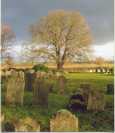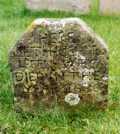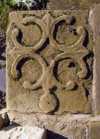For this church:    |
Norwell St LaurenceChurchyard
The churchyard surrounds the church which is placed well towards the northern boundary, abutting the Cromwell Road. The old churchyard is roughly rectangular and has an area of 1.291 acres (0.516 hectares). There are graves to the east, south and west of the churchyard, with a small number and a railed enclosure to the north. In 1967 an area towards the south east was cleared of headstones when a Son et Lumière was staged in Norwell church. In 1924 a triangular piece of land (0.3 acres, 0.12 hectares) contiguous to the south east of the old churchyard was added to form the new churchyard. Both old and new churchyards are still used for burials. A brick wall forms the boundary to the north and west of the churchyard, and the western section of the southern boundary. There is a record of the purchase of 10,000 bricks for the church wall in 1701; in 1874 the churchyard wall was reduced in height. The walls are topped with triangular shaped coping-stones and, with the exception of the eastern end of the north wall, have ashlar stones incorporated in the base. It is possible that some of these stones may have come from the adjoining Overhall Prebendal Manor House which fell into disrepair in the eighteenth century. The eastern boundary and that of the new churchyard have hawthorn hedges. In 1764 the south and east boundaries were ‘fenced with quicksetts and pale, upheld by the person who occupies the land adjoining’, and in 1767 some mounds in the churchyard were levelled. The eastern end of the south boundary is post and rail fence. In 1856, prior to the restoration Ewan Christan wrote a full description of the fencing, arguing against the replacement of the hedge by a wall, saying ‘The hedge is a far more efficient fence than a wall would be, and the openings between the thorns with fine trees standing in the midst ... give so much light and variety to the scenery that I think it would be quite wrong to disturb it.’
There are two entrances to the churchyard. The main entrance is through a wooden gate at the north western corner. A curved path, over-arched by laurel and yew, leads to the south porch. There is also a gate at the north eastern corner. In the churchyard there are some fine mature trees. The majority of the yews were planted at the time of the restoration in the late nineteenth century. There is a typically spreading horse chestnut tree about two hundred years old. In addition there is a walnut, lime and sycamore as well as holly and various conifers. There is a rich flora including a large number of primroses in the spring. Rabbits and moles are also present in considerable numbers. Headstones and other tombs
There are many upright headstones in all parts of the churchyard. The most worthy of note are the three seventeenth-century headstones: Richard Uffen 1686, Henry Taylor 1693 and Thomas Roberts 1698. They are distinguished by being shorter and thicker than later headstones. Also of interest are the nineteenth century chest or box tombs towards the east end of the churchyard. Several families have collections of tombs in the churchyard. To the east of the south porch is the railed enclosure containing the Dennistouns and Skeffingtons from Carlton Hall. To the right of the path as one enters the churchyard are the memorials to the Templeman Herring dynasty with nineteen headstones for the Templemans and six for the Herrings. There are burials to the north of the church; in a railed enclosure between the chancel and north transept there are crosses for three children of George Hutton Riddell (a member of the Hutton Riddell family is commemorated in the east window of the north transept immediately behind the graves), and outside the enclosure a cross for three members of the Teather family.
A sandstone grave-marker of around 1200, with a simple geometrical cross design in relief, was broken in to pieces and used to form part of a ramp, replacing a step into the porch, in the 1970s. The head of the cross (46cm wide x 56cm long) remains to the right of the door, and part of the shaft (32mm wide on a fragment c39cm wide x 53cm long) is visible on the left. This stone probably originally marked the grave of an early prebendary or vicar and from its relatively undeveloped form could date from the late 12th or early 13th century. Three Norwell vicars are buried in the churchyard: Edmund Herring, James Morris Maxfield and William Hutton. A plan of the tombs and headstones in the old and new churchyards is available in the vestry. Sundial
In the south west section of the churchyard is an early pedestal sundial of considerable interest. The dial itself is dated 1665, but the pedestal on which it is mounted is dated 1736 and bears the names of two church wardens, Richard Wright and Richard Birkett, who were probably responsible for putting it up. There is also a mass dial, or scratch dial on the south west buttress of the south transept; part of a reused mass dial on the south east wall of the entrance to the south porch; and, possibly, another much-eroded scratch dial on the south-west butress of the tower. War memorialThe War Memorial is in the north west section of the churchyard overlooking the Cromwell Road. |











